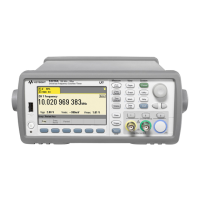210 53220A/53230A User’s Guide
6 53220A/53230A Math, Graphing, and Data Logging
• setting both limits on the same line programmatically
• enabling limit testing after the limits are set
To programmatically determine if a reading (or readings) outside the limit
boundaries has occurred, the command:
STATus:QUEStionable:EVENt?
is used to read the Questionable Data register. A value of +2048 (bit 11) indi-
cates a reading below the lower limit. A value of +4096 (bit 12) indicates a
reading above the upper limit. Reading the register also clears all bits in the
register (see “Clearing Limit Conditions).
Example: Limit Checking
The following is an example of enabling and using limit checking.
CONF:FREQ (@1) // configure measurement
SAMP:COUN 500 // check limit on 500 rdgs
CALC:STAT ON // enable math operations
CALC:LIM:STAT ON // enable limit checking
CALC:LIM:LOW 99.9E3;UPP 100.1E3 // set limits
INIT // initiate the measurements
*WAI // wait for readings to complete
STAT:QUES:EVEN? // query questionable data register
Notice that the limits are set on the same line to prevent a settings conflict
error. This Error can also be avoided by enabling limit checking after the lim-
its are set.
Clearing Limit Conditions
The ‘Limit’ annunciator is turned off and bits 11 and 12 (only) in the Question-
able Data Register are cleared by any of the following:

